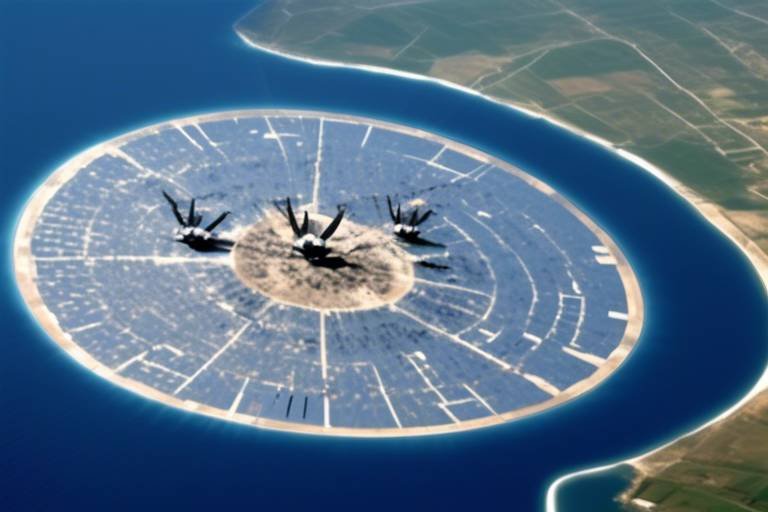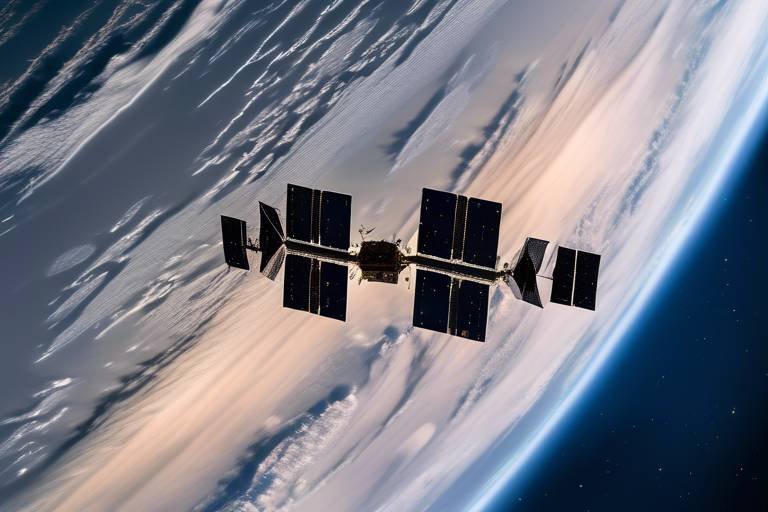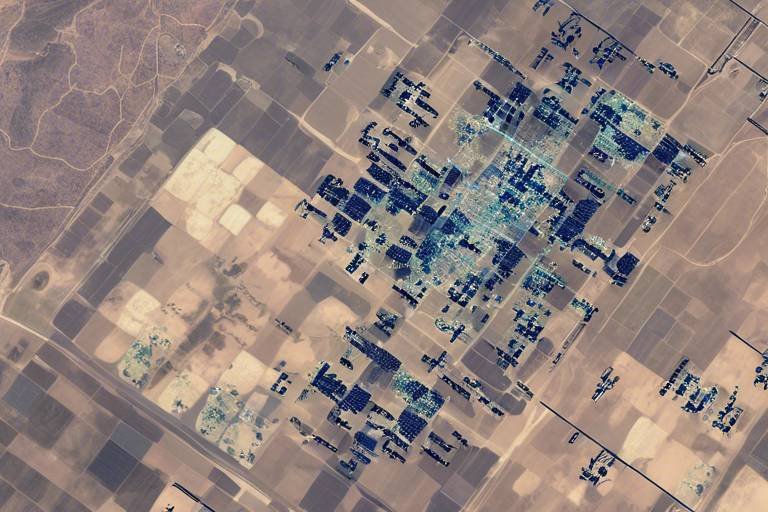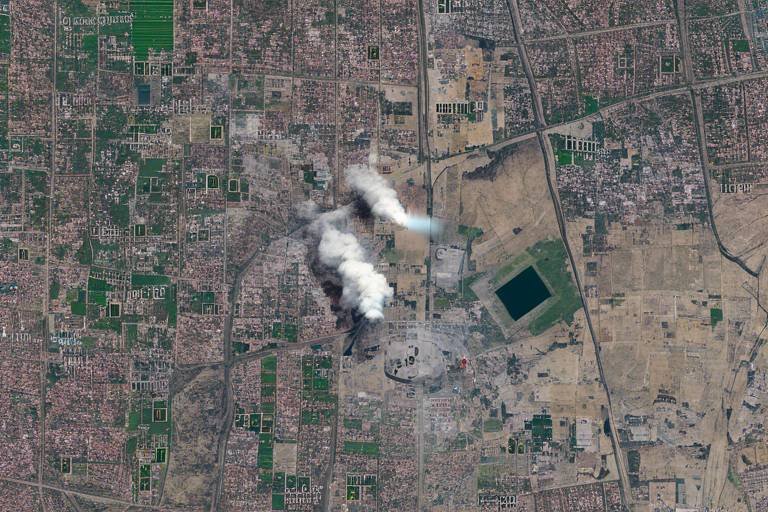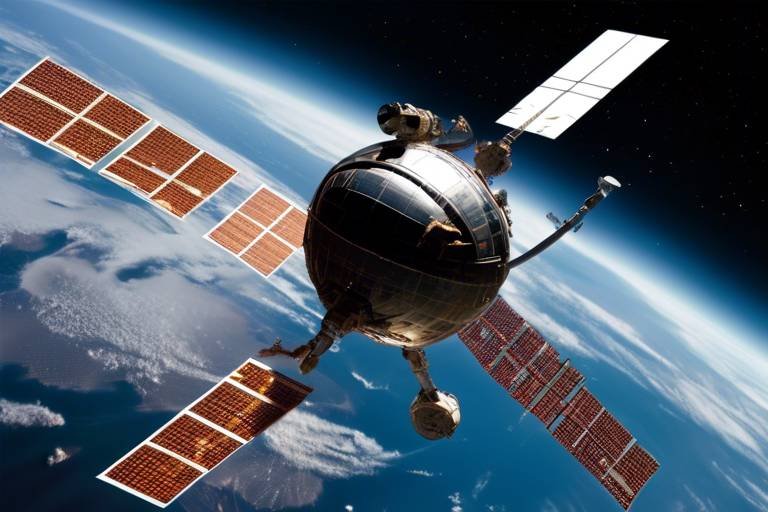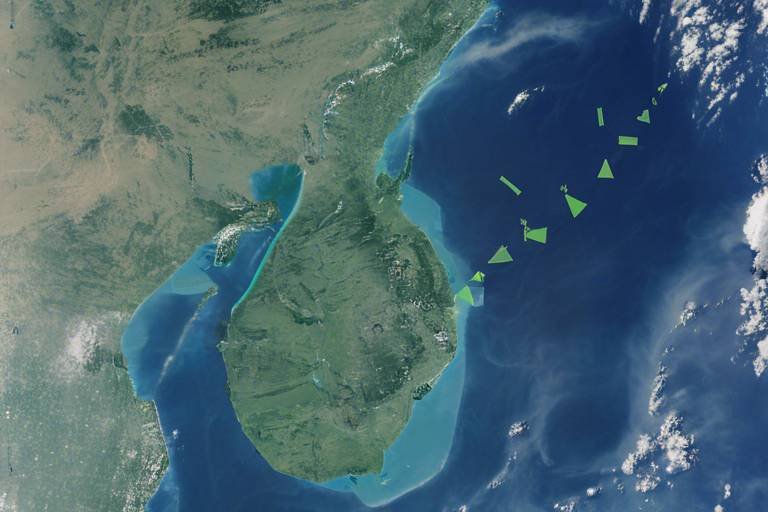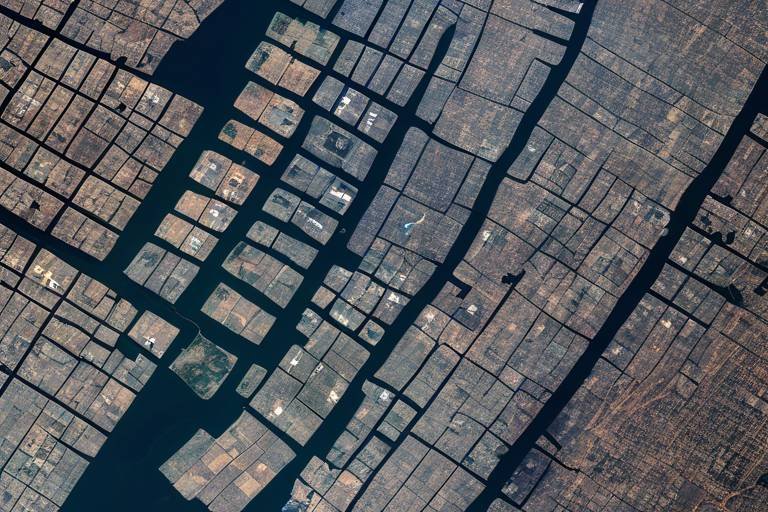How Satellites Aid in Coordination for Multinational Forces
The modern battlefield is a complex, ever-evolving landscape where success hinges on effective communication and precise coordination among multinational forces. In this intricate web of operations, satellites emerge as the unsung heroes, playing a pivotal role in enhancing the capabilities of military units from different nations. Imagine a vast orchestra, where each musician represents a different country, and the conductor is the satellite system ensuring that everyone plays in harmony. This article delves into the critical functions satellites serve in improving communication, navigation, and data sharing among these forces, ultimately leading to operational efficiency and mission success.
At the heart of multinational military operations lies satellite communication systems, which facilitate real-time data exchange across vast distances. Picture a scenario where troops are stationed miles apart, yet they can communicate instantaneously, sharing vital information that could mean the difference between victory and defeat. These systems are essential for maintaining seamless communication, allowing forces to coordinate maneuvers, share intelligence, and execute complex operations without missing a beat. With satellites, nations can overcome the limitations of traditional communication methods, ensuring that every unit is on the same page, no matter where they are located.
Global Navigation Satellite Systems (GNSS) are another cornerstone of military operations, providing precise positioning data critical for troop movements and logistics. Imagine a massive chessboard, where every piece must be moved strategically. GNSS acts as the guiding hand, ensuring that each unit knows its exact location and can navigate effectively on the battlefield. This capability is particularly vital for multinational forces, as it allows them to synchronize their actions, ensuring that everyone is moving in the right direction at the right time. Whether it’s coordinating air support or managing ground troop movements, accurate positioning is key to operational success.
Access to satellite imagery and data transforms the decision-making process for commanders. With high-resolution images and real-time data at their fingertips, leaders can enhance their situational awareness and make informed tactical decisions. This capability is akin to having a bird's-eye view of the battlefield, allowing commanders to anticipate enemy movements and adjust their strategies accordingly. The speed at which information is processed and shared can significantly reduce response times, enabling multinational forces to act swiftly and decisively in joint operations.
One of the most significant advantages of satellite technology is the ability to disseminate intelligence rapidly. Multinational forces can stay updated on enemy movements, allowing them to adapt their strategies in real-time. This constant flow of information is crucial for mission success, as it enables units to remain one step ahead of potential threats. The agility that comes from effective intelligence sharing can be the game-changer in high-stakes military operations.
With advanced satellite technology, forces can significantly improve their targeting accuracy. This capability is vital for minimizing collateral damage and increasing operational effectiveness during joint missions. Imagine a surgeon performing a delicate operation; precision is everything. Similarly, accurate targeting ensures that military actions are focused and effective, reducing the risk of unintended consequences while achieving mission objectives. This level of precision is particularly important in multinational operations, where the stakes are high, and the consequences of failure can be dire.
Logistics and supply chain management are critical components of military operations, and satellites play a crucial role in ensuring the timely delivery of resources and support across different operational theaters. Think of satellites as the backbone of a vast supply network, enabling real-time tracking and management of supplies. This capability allows multinational forces to coordinate their logistics effectively, ensuring that troops have the necessary resources when and where they need them. In an environment where every second counts, the efficiency provided by satellite technology can be the difference between success and failure.
Despite the numerous advantages, coordinating satellite operations among various nations is not without its challenges. Issues such as interoperability, security concerns, and the need for standardized protocols can complicate efforts to harness the full potential of satellite technology. These obstacles require collaborative efforts among nations to establish compatible systems and protocols, ensuring that all forces can communicate and operate seamlessly.
Different military systems and technologies can create barriers to effective satellite communication. Imagine trying to fit puzzle pieces together that don’t quite match; it can be frustrating and inefficient. To overcome these interoperability issues, nations must work together to establish compatible systems that facilitate seamless communication during multinational operations. This collaboration is essential for maximizing the effectiveness of satellite technology in joint missions.
The reliance on satellite systems raises significant concerns about potential cyber threats. As nations increasingly depend on these technologies, the need for robust security measures becomes paramount. Protecting sensitive information and maintaining operational integrity is crucial for multinational forces. Just as a fortress needs strong walls to defend against invaders, military forces must implement stringent cybersecurity protocols to safeguard their satellite communications from potential threats.
Looking ahead, advancements in satellite technology promise to further enhance the capabilities of multinational forces. Innovations in data analytics, improved connectivity, and greater resilience in complex operational environments will enable more efficient coordination among nations. As technology continues to evolve, the potential for satellites to transform military operations is limitless, paving the way for a new era of collaboration and effectiveness on the battlefield.
- How do satellites improve communication among multinational forces?
Satellites facilitate real-time data exchange, enabling seamless communication across vast distances, which is crucial for coordinated operations. - What role do Global Navigation Satellite Systems (GNSS) play in military operations?
GNSS provides precise positioning data, essential for troop movements and logistics, ensuring effective coordination on the battlefield. - What challenges do nations face when coordinating satellite operations?
Challenges include interoperability issues, security concerns, and the need for standardized protocols to ensure effective communication.
The Role of Satellite Communication
In today's fast-paced military landscape, satellite communication systems are nothing short of revolutionary. They serve as the backbone for real-time data exchange, enabling multinational forces to maintain seamless communication across vast distances. Imagine trying to coordinate a complex operation involving troops from multiple countries without the ability to communicate instantly—it's a logistical nightmare! That's where satellites come into play, ensuring that every unit, regardless of its location, can stay connected and informed.
One of the most significant benefits of satellite communication is its ability to facilitate coordinated operations. In joint missions, where forces from different nations collaborate, the need for effective communication becomes paramount. Whether it's sharing intelligence, updating operational plans, or relaying critical information, satellites bridge the gaps that traditional communication methods often struggle to cover. For instance, during a multinational exercise, a command center can communicate with ground troops in real-time, ensuring that everyone is on the same page and can respond to changes in the situation promptly.
Moreover, satellite systems are not just about voice communication; they encompass a wide array of data services. From transmitting video feeds to sharing sensitive intelligence reports, these systems enhance the ability of commanders to make informed decisions. The technology behind satellite communication has evolved significantly, allowing for higher bandwidth and better encryption, which are essential for secure military operations. In fact, modern military satellites are equipped with advanced features that enable them to support a variety of communication needs, including:
- Secure Voice Communication: Ensures that sensitive conversations remain confidential.
- Data Transmission: Facilitates the quick sharing of intelligence and operational data.
- Video Conferencing: Allows commanders to conduct meetings with personnel located worldwide.
As we delve deeper into the realm of satellite communication, it's also important to recognize the role of satellite constellations. These networks of satellites work together to provide extensive coverage and redundancy, making sure that communication lines remain open even if one satellite goes offline. This is particularly crucial in military operations where every second counts. If a satellite is compromised or fails, the remaining satellites in the constellation can take over, ensuring that communication is not interrupted.
In conclusion, the role of satellite communication in enhancing the operational efficiency of multinational forces cannot be overstated. By providing reliable, real-time communication capabilities, satellites enable diverse military units to coordinate effectively, adapt to changing circumstances, and ultimately achieve mission success. As technology continues to advance, we can only expect satellite communication to become even more integral to military operations around the globe.
Navigation and Positioning Systems
When it comes to coordinating multinational forces, Global Navigation Satellite Systems (GNSS) are nothing short of revolutionary. Imagine trying to navigate a vast, uncharted territory without a map or compass; that's how chaotic military operations would be without these advanced systems. GNSS provides precise positioning data that is absolutely critical for troop movements, logistics, and overall mission success. Whether it's tracking the location of friendly units or pinpointing the enemy's position, accurate navigation is the backbone of effective military operations.
One of the most significant advantages of GNSS is its ability to deliver real-time data. This means that commanders can make informed decisions based on the most current information available. For instance, if a unit is moving through a dense forest and encounters unexpected obstacles, GNSS can help them quickly reroute to avoid delays. This agility in navigation is crucial, especially in fast-paced combat situations where every second counts.
Moreover, GNSS enhances logistical operations. Imagine a multinational force operating in a remote area where supply lines are stretched thin. With accurate positioning data, logistics teams can ensure that supplies reach their destinations on time, preventing any potential bottlenecks that could jeopardize the mission. This capability is particularly important when dealing with multiple nations' forces, as it allows for synchronized efforts in resource management.
To illustrate the importance of GNSS in military operations, consider the following table that outlines key benefits:
| Benefit | Description |
|---|---|
| Precision | Provides exact location data for troops and resources, minimizing the risk of miscommunication. |
| Real-Time Updates | Allows for immediate adjustments in strategy based on the latest information. |
| Enhanced Coordination | Facilitates seamless collaboration between different nations' forces, ensuring everyone is on the same page. |
| Logistical Efficiency | Ensures timely delivery of supplies and resources, crucial for mission success. |
However, it's important to remember that while GNSS technology is incredibly beneficial, it also comes with its own set of challenges. For example, environmental factors such as dense urban areas or mountainous terrain can disrupt satellite signals, leading to inaccuracies. Additionally, reliance on satellite systems makes forces vulnerable to jamming or other electronic warfare tactics that adversaries may employ. Therefore, while GNSS is a game-changer for navigation and positioning, military planners must consider these vulnerabilities and develop contingency plans to address them.
In conclusion, the integration of GNSS into multinational military operations is a prime example of how technology can enhance efficiency and effectiveness on the battlefield. As these systems continue to evolve, we can expect even greater improvements in navigation and positioning, paving the way for more successful joint missions.
- What is GNSS? Global Navigation Satellite Systems (GNSS) are satellite systems that provide geolocation and time information to a GPS receiver anywhere on Earth.
- How does GNSS improve military operations? It enhances navigation accuracy, allows for real-time data sharing, and improves logistics and supply chain management.
- What are the challenges associated with GNSS? Challenges include environmental disruptions, potential jamming, and the need for interoperability among different nations' systems.
Improving Tactical Decision-Making
In the fast-paced world of military operations, time is of the essence. Commanders on the ground often face daunting challenges that require swift and informed decision-making. This is where satellite technology steps in, acting as a lifeline for tactical decision-making. By providing real-time satellite imagery and data, military leaders can assess the battlefield with unprecedented clarity. Imagine trying to navigate a maze blindfolded; that’s what commanders face without accurate information. Satellites remove the blindfold, offering a comprehensive view of the terrain and enemy movements.
One of the most significant advantages of satellite technology is its ability to enhance situational awareness. With access to high-resolution images and data feeds, commanders can quickly identify changes in the battlefield landscape, such as troop movements or potential ambush sites. This capability is akin to having a bird’s eye view of the battlefield, allowing for a more strategic approach to operations. Moreover, the integration of satellite data with other intelligence sources creates a more robust picture of the operational environment, enabling commanders to adapt their strategies in real-time.
Furthermore, the ability to share intelligence rapidly among multinational forces is crucial. For instance, consider a scenario where multiple countries are engaged in a joint operation. Using satellites, they can share vital information instantly, ensuring that all parties are on the same page. This collaborative approach not only enhances tactical decision-making but also fosters trust and cooperation among allied nations. The result? A more cohesive response to threats, where every unit operates as a well-oiled machine.
Additionally, the use of advanced analytics powered by satellite data can significantly improve decision-making processes. By analyzing patterns and trends in the data, commanders can predict enemy actions and plan their maneuvers accordingly. This predictive capability is similar to forecasting weather; just as a meteorologist uses data to predict storms, military leaders can leverage satellite information to anticipate battlefield dynamics. This foresight can be the difference between success and failure in critical operations.
In conclusion, the role of satellites in improving tactical decision-making is undeniable. By providing real-time data, enhancing situational awareness, facilitating rapid intelligence sharing, and enabling advanced analytics, satellite technology equips commanders with the tools they need to make informed decisions swiftly. As military operations continue to evolve, the integration of satellite technology will remain a cornerstone of effective tactical planning.
- How do satellites enhance communication in military operations?
Satellites facilitate real-time communication across vast distances, ensuring that multinational forces can coordinate their actions effectively.
- What is the importance of situational awareness in military operations?
Situational awareness allows commanders to understand the battlefield dynamics, leading to better-informed decisions and improved operational effectiveness.
- What challenges do multinational forces face in satellite coordination?
Challenges include interoperability issues between different military systems, security concerns regarding cyber threats, and the need for standardized protocols.
Real-Time Intelligence Sharing
In the fast-paced world of military operations, has become a game-changer for multinational forces. Imagine a scenario where every unit on the ground has immediate access to crucial information about enemy movements, terrain changes, and logistical needs. This level of situational awareness is not just beneficial; it's essential for mission success. Satellites play a pivotal role in this process by enabling the rapid dissemination of intelligence across vast distances, ensuring that all participating forces remain informed and agile.
When we think about the battlefield, we often picture soldiers on the ground, but the truth is that modern warfare is a complex web of interconnected units operating in unison. Satellites act as the backbone of this network, allowing commanders to gather data from various sources, including drones and reconnaissance flights. This data is then analyzed and shared in real-time, which is crucial for making informed decisions. For example, if one unit spots enemy activity, that information can be instantly relayed to other units, allowing them to adapt their strategies on the fly.
Furthermore, the integration of advanced satellite technologies has led to the development of sophisticated systems that can process and visualize intelligence data. This not only helps in sharing information but also in understanding it. Commanders can access live feeds and maps that highlight enemy positions, troop movements, and even potential ambush points. With this level of detail, the margin for error is significantly reduced, and the chances of success in joint operations increase dramatically.
To illustrate the impact of real-time intelligence sharing, consider the following table that outlines key benefits:
| Benefit | Description |
|---|---|
| Enhanced Situational Awareness | Units receive up-to-date information on enemy movements and environmental changes. |
| Improved Coordination | Different military units can synchronize their actions effectively, reducing miscommunication. |
| Faster Response Times | Commanders can make quick decisions based on the latest intelligence, adapting strategies in real-time. |
However, with great power comes great responsibility. The reliance on satellite systems for intelligence sharing also introduces vulnerabilities. Cybersecurity threats loom large, as adversaries may attempt to intercept or manipulate the data being shared. Therefore, multinational forces must invest in robust security protocols to safeguard their communications. This involves not only protecting the data but also ensuring that the systems used for sharing intelligence are resilient against potential attacks.
In conclusion, real-time intelligence sharing facilitated by satellites is a cornerstone of modern military operations. It empowers multinational forces to operate more effectively in joint missions, enhances their situational awareness, and ultimately increases the likelihood of achieving operational goals. As technology continues to advance, the potential for even more sophisticated systems will only strengthen the capabilities of these forces, making them more adaptable and resilient in the face of challenges.
Enhanced Targeting Capabilities
In the modern battlefield, precision is everything. The ability to accurately identify and engage targets can mean the difference between mission success and catastrophic failure. This is where satellite technology steps in, revolutionizing how multinational forces conduct operations. By leveraging advanced satellite systems, military units can enhance their targeting capabilities significantly.
Imagine a scenario where troops are deployed in a foreign land, working alongside allied forces from different nations. Each unit has its own set of equipment, communication protocols, and operational guidelines. Despite these differences, the integration of satellite technology allows for a unified approach to targeting. With real-time data streaming from satellites, commanders can access high-resolution imagery that provides a clear picture of the battlefield.
With the help of satellite imagery, forces can pinpoint enemy positions with remarkable accuracy. This allows for the development of highly detailed operational plans that take into account not just the enemy's location, but also the surrounding environment. For instance, understanding the terrain can help in deciding the best approach for an operation, minimizing risks to troops and civilians alike.
Moreover, satellite technology plays a crucial role in collaborative targeting among multinational forces. When different nations work together, it’s vital that they share the same information. This is achieved through secure satellite communications that allow for the rapid exchange of targeting data. Consequently, forces can coordinate strikes more effectively, reducing the likelihood of miscommunication and friendly fire incidents.
To illustrate the impact of enhanced targeting capabilities, consider the following table that outlines the benefits of satellite-assisted targeting:
| Benefit | Description |
|---|---|
| Increased Accuracy | Real-time data allows for precise identification of targets, minimizing collateral damage. |
| Faster Response Times | Immediate access to satellite imagery speeds up decision-making processes during operations. |
| Improved Coordination | Shared satellite data enhances collaboration among allied forces, ensuring unified efforts. |
| Reduced Risks | Better targeting reduces the chances of civilian casualties and protects military personnel. |
In addition to these benefits, the use of satellite technology for targeting also allows for the integration of advanced data analytics. By analyzing patterns and movements over time, military strategists can predict enemy behavior and adapt their tactics accordingly. This predictive capability is a game-changer, enabling forces to stay one step ahead in an ever-evolving battlefield environment.
In conclusion, the enhanced targeting capabilities provided by satellite technology not only improve the operational effectiveness of multinational forces but also contribute to greater mission success rates. As technology continues to advance, we can expect even more sophisticated systems that will further refine targeting processes, making joint operations safer and more efficient.
- How do satellites improve communication among multinational forces?
Satellites facilitate real-time data exchange, allowing forces from different nations to communicate seamlessly across vast distances. - What is the role of satellite imagery in military operations?
Satellite imagery provides commanders with a detailed view of the battlefield, enhancing situational awareness and aiding in tactical decision-making. - How does satellite technology enhance targeting capabilities?
By providing accurate, real-time data, satellite technology allows forces to identify and engage targets with precision, reducing collateral damage. - What challenges do multinational forces face in coordinating satellite operations?
Challenges include interoperability issues, security concerns, and the need for standardized protocols among different nations' military systems.
Logistics and Supply Chain Management
This article explores the vital role satellites play in enhancing communication, navigation, and data sharing among multinational military forces, ultimately improving operational efficiency and effectiveness in joint missions.
Satellite communication systems facilitate real-time data exchange, enabling multinational forces to maintain seamless communication across vast distances, which is essential for coordinated operations and mission success.
Global Navigation Satellite Systems (GNSS) provide precise positioning data critical for troop movements and logistics, ensuring that multinational forces can effectively coordinate their actions on the battlefield.
Access to satellite imagery and data allows commanders to make informed tactical decisions, enhancing situational awareness and reducing response times during joint operations among diverse military units.
Satellites enable the rapid dissemination of intelligence, allowing multinational forces to stay updated on enemy movements and adapt strategies accordingly, contributing to mission success.
With satellite technology, forces can improve targeting accuracy, minimizing collateral damage and increasing operational effectiveness during joint missions involving multiple nations.
In the complex world of military operations, logistics and supply chain management are critical components that can make or break a mission. Satellites play a pivotal role in this arena, acting as the backbone for communication and coordination of resources. Imagine a vast web of interconnected units spread across different terrains, each requiring timely supplies and support to function effectively. Here, satellites serve as the lifeline that ensures every unit is well-equipped and ready for action.
Through satellite technology, multinational forces can track the movement of supplies in real-time, which is essential for maintaining operational momentum. This capability allows for the optimization of supply routes, reducing delays and ensuring that troops receive the necessary resources when they need them the most. For instance, a supply convoy can be rerouted based on satellite data that indicates enemy activity or unfavorable weather conditions, thereby enhancing the safety and effectiveness of logistics operations.
Moreover, the integration of satellite systems with other logistical tools enables better forecasting and inventory management. By analyzing data collected from satellites, military planners can predict supply needs based on troop movements and mission requirements. This proactive approach not only saves time but also minimizes waste, ensuring that resources are utilized efficiently.
To illustrate the impact of satellite technology on logistics, consider the following table:
| Logistics Function | Traditional Method | Satellite-Enhanced Method |
|---|---|---|
| Supply Tracking | Manual reporting | Real-time satellite tracking |
| Route Optimization | Static planning | Dynamic rerouting based on live data |
| Inventory Management | Periodic checks | Continuous monitoring via satellite |
In summary, the integration of satellite technology into logistics and supply chain management is not just a technological advancement; it is a game-changer for multinational forces. By providing real-time data and enabling proactive decision-making, satellites ensure that troops are always ready, equipped, and able to respond to the demands of any mission.
Despite their advantages, coordinating satellite operations among various nations poses challenges, including interoperability issues, security concerns, and the need for standardized protocols.
Different military systems and technologies can create barriers to effective satellite communication, necessitating collaborative efforts to establish compatible systems for multinational operations.
The reliance on satellite systems raises concerns about potential cyber threats, requiring multinational forces to implement robust security measures to protect sensitive information and maintain operational integrity.
Advancements in satellite technology promise to further enhance the capabilities of multinational forces, enabling more efficient coordination, improved data analytics, and greater resilience in complex operational environments.
- How do satellites improve communication among multinational forces?
Satellites enable real-time data exchange, allowing forces from different nations to communicate seamlessly regardless of distance. - What role do satellites play in logistics?
Satellites provide real-time tracking and monitoring of supplies, helping to optimize routes and ensure timely delivery of resources. - Are there security risks associated with satellite operations?
Yes, the reliance on satellite systems raises concerns about potential cyber threats, necessitating robust security measures. - How can satellite technology enhance tactical decision-making?
Access to satellite imagery and data allows commanders to make informed decisions, improving situational awareness and response times.
Challenges in Satellite Coordination
While satellites have revolutionized military operations, their coordination among multinational forces is not without its challenges. One of the most pressing issues is interoperability. Different countries often utilize varied military systems and technologies, which can create significant barriers to effective satellite communication. Imagine trying to communicate with someone who speaks a different language; without a common tongue, the message is lost. Similarly, without collaborative efforts to establish compatible systems, multinational operations may face delays and miscommunications that could jeopardize mission success.
Another challenge lies in the realm of security. The reliance on satellite systems raises concerns about potential cyber threats. As military operations become increasingly digitized, the risk of cyberattacks grows. These threats can compromise sensitive information, leading to dire consequences on the battlefield. Consequently, multinational forces must implement robust security measures to protect their satellite communications. This includes encryption, regular security audits, and continuous monitoring of satellite systems to detect any anomalies that could indicate a breach.
Moreover, the need for standardized protocols cannot be overlooked. Each nation may have its own set of operational procedures, which can complicate joint missions. Without a unified approach, the likelihood of miscommunication increases, potentially leading to operational inefficiencies. For instance, if one nation operates on a different frequency or communication protocol, it can create confusion among allied forces, ultimately affecting the overall effectiveness of the mission.
To tackle these challenges, multinational forces must engage in open dialogues and collaborative exercises that foster understanding and build trust among different military branches. This could involve joint training sessions that focus specifically on satellite operations or establishing a shared framework for communication protocols. The goal is to create an environment where information flows seamlessly, enhancing the ability of diverse military units to work together effectively.
In conclusion, while the advantages of satellite technology in military coordination are undeniable, addressing the challenges of interoperability, security, and standardized protocols is crucial. By overcoming these obstacles, multinational forces can harness the full potential of satellite systems, ensuring that they can operate with greater efficiency and effectiveness on the global stage.
- What are the main challenges in satellite coordination for military operations?
The primary challenges include interoperability issues, security concerns, and the need for standardized protocols among different nations. - How do interoperability issues affect multinational military operations?
Interoperability issues can lead to miscommunications and operational inefficiencies, as different countries may use incompatible systems and technologies. - What measures can be taken to enhance satellite security?
Implementing robust security measures such as encryption, regular audits, and continuous monitoring can help protect sensitive satellite communications from cyber threats. - Why is standardization important in satellite operations?
Standardization is crucial to ensure that all participating nations can communicate effectively and operate seamlessly during joint missions.
Interoperability Issues
When it comes to coordinating multinational military operations, interoperability is a crucial factor that can make or break mission success. Imagine trying to put together a jigsaw puzzle where the pieces come from different boxes; that’s essentially what happens when various nations attempt to work together with their unique military systems and technologies. Each country has its own protocols, equipment, and communication systems, which can create significant barriers to effective satellite communication.
For instance, consider the differences in frequency bands used by different nations. If one country operates on a frequency that another cannot access, it leaves a gaping hole in communication, akin to trying to talk to someone who speaks a different language without a translator. This lack of compatibility can lead to delays in information sharing, miscommunication, and even operational failures. In a high-stakes environment like military operations, where every second counts, these interoperability issues can be detrimental.
To tackle these challenges, nations must engage in collaborative efforts to establish compatible systems. This often involves the creation of standardized protocols that can facilitate seamless communication across different military branches. Countries may need to invest in joint training exercises, where troops from various nations practice using shared technologies and systems. Such initiatives not only enhance technical interoperability but also foster trust and camaraderie among forces. The table below highlights some key aspects of interoperability challenges:
| Challenges | Potential Solutions |
|---|---|
| Different communication protocols | Developing standardized communication systems |
| Varying equipment capabilities | Joint training and exercises |
| Incompatible software systems | Creating interoperable software solutions |
Moreover, it’s essential to recognize that interoperability is not just a technical issue; it also involves cultural understanding and operational philosophies. Each nation has its own military doctrines and approaches to warfare, which can influence how they utilize satellite technology. For example, one country might prioritize speed and agility, while another may focus on thorough reconnaissance and planning. Bridging these differences requires open communication and a willingness to adapt. As nations work together, they must cultivate a shared understanding of each other's operational methods, which can significantly enhance interoperability.
In conclusion, while interoperability issues present significant challenges for multinational forces relying on satellite technology, they are not insurmountable. By investing in compatible systems, joint training, and fostering cultural understanding, nations can improve their operational efficiency and effectiveness. Ultimately, overcoming these hurdles will lead to more cohesive and successful joint missions, ensuring that forces can work together seamlessly in the face of adversity.
- What is interoperability in military operations? Interoperability refers to the ability of military forces from different nations to communicate and operate together effectively, utilizing compatible systems and protocols.
- Why is interoperability important for multinational forces? It is vital for ensuring seamless communication and coordination during joint missions, which enhances operational efficiency and effectiveness.
- What are some common interoperability challenges? Common challenges include different communication protocols, varying equipment capabilities, and incompatible software systems.
- How can nations improve interoperability? Nations can improve interoperability through joint training exercises, developing standardized communication systems, and fostering cultural understanding among forces.
Security and Cyber Threats
The reliance on satellite systems in military operations, while advantageous, brings with it a host of that can jeopardize the integrity of multinational missions. Imagine a scenario where critical communication lines are compromised, or sensitive intelligence is intercepted by adversaries. This is not just a hypothetical situation; it is a real concern that military leaders must address. As multinational forces increasingly depend on satellite technology for communication, navigation, and data sharing, the potential for cyber attacks becomes a pressing issue.
One of the primary threats comes from cybercriminals and hostile nation-states who seek to exploit vulnerabilities in satellite systems. These attacks can range from simple jamming of signals to sophisticated hacking attempts aimed at stealing classified information. The consequences of such breaches can be catastrophic, leading to miscommunication, operational failures, and loss of life. Thus, it is imperative for military organizations to not only invest in advanced satellite technology but also in robust cybersecurity measures to safeguard their operations.
To combat these threats, multinational forces must adopt a proactive approach that includes:
- Regular Security Audits: Conducting frequent assessments of satellite systems to identify and rectify vulnerabilities.
- Advanced Encryption: Utilizing state-of-the-art encryption techniques to protect data transmitted via satellite.
- Interagency Collaboration: Sharing intelligence and resources among allied nations to strengthen defenses against cyber threats.
Moreover, training personnel to recognize and respond to potential cyber threats is crucial. This includes not only technical training but also developing a culture of cybersecurity awareness within military ranks. By fostering an environment where every member is vigilant and informed, multinational forces can enhance their overall security posture.
In conclusion, while satellites are invaluable assets for multinational military operations, they also present unique security challenges that must be addressed. By implementing stringent cybersecurity protocols and fostering international cooperation, military forces can protect their satellite systems from cyber threats, ensuring that they can operate effectively in an increasingly complex and hostile environment.
- What are the main security threats to satellite systems? The main threats include cyber attacks, signal jamming, and unauthorized access to sensitive data.
- How can multinational forces improve their satellite security? By conducting regular security audits, employing advanced encryption, and fostering interagency collaboration.
- Why is cybersecurity training important for military personnel? Training helps personnel recognize potential threats and respond effectively, which is crucial for maintaining operational integrity.
The Future of Satellite Technology in Military Operations
As we look toward the horizon of military operations, the evolution of satellite technology is poised to revolutionize how multinational forces coordinate and execute their missions. The future is not just about enhancing existing capabilities; it's about transforming the very fabric of military strategy. Imagine a world where real-time data analytics, advanced artificial intelligence, and next-generation satellites converge to create an operational landscape that is more efficient and responsive than ever before. This is not a distant dream; it's on the cusp of becoming reality.
One of the most exciting developments is the integration of low Earth orbit (LEO) satellites. Unlike traditional geostationary satellites that orbit far above the Earth, LEO satellites operate much closer to the surface, significantly reducing latency. This means that communication delays are minimized, allowing for instantaneous data exchange. For multinational forces, this can be the difference between success and failure in high-stakes situations. With the ability to communicate and share data in real-time, commanders can make swift decisions, adapting to the evolving battlefield dynamics.
Moreover, the advent of artificial intelligence (AI) in satellite operations is another game-changer. AI can process vast amounts of data collected from satellites, identifying patterns and providing actionable insights that human operators might miss. This capability enhances situational awareness, enabling military leaders to anticipate enemy movements and make informed tactical decisions. The combination of AI and satellite technology will allow for a level of predictive analysis that could redefine military strategy in joint operations.
Furthermore, we can expect to see advancements in satellite imagery and reconnaissance capabilities. Enhanced imaging technology will provide clearer, more detailed views of the battlefield, allowing forces to track troop movements, equipment placements, and even environmental changes that could impact operations. This real-time intelligence is crucial for multinational forces that need to coordinate actions across diverse terrains and operational theaters.
However, with these advancements come challenges. The increasing reliance on satellite technology opens the door to potential cyber threats. As military operations become more dependent on these systems, ensuring their security will be paramount. Multinational forces must collaborate to develop robust cybersecurity measures that protect sensitive information from malicious actors. This collaboration will not only enhance security but also promote interoperability among different nations' military systems.
In addition, the future of satellite technology will likely involve the development of standardized protocols for data sharing and communication. As nations work together in joint operations, having a common framework will facilitate smoother interactions and reduce the risk of miscommunication. This standardization will be critical in ensuring that all forces, regardless of their origin, can operate cohesively and effectively.
In conclusion, the future of satellite technology in military operations is bright and full of potential. With advancements in LEO satellites, AI integration, enhanced imagery, and a focus on cybersecurity and standardization, multinational forces are set to achieve unprecedented levels of coordination and operational efficiency. As we embrace these innovations, the landscape of military strategy will evolve, paving the way for a new era of collaboration and effectiveness on the battlefield.
- What role do satellites play in military operations?
Satellites facilitate communication, navigation, and data sharing among multinational forces, enhancing operational efficiency and effectiveness. - How do LEO satellites differ from traditional satellites?
LEO satellites operate closer to the Earth, resulting in reduced latency and faster communication capabilities. - What is the impact of AI on satellite technology in military contexts?
AI enhances data processing and situational awareness, enabling quicker and more informed decision-making for commanders. - What challenges do multinational forces face with satellite coordination?
Challenges include interoperability issues, security threats, and the need for standardized protocols for effective communication.
Frequently Asked Questions
- How do satellites improve communication among multinational forces?
Satellites facilitate real-time data exchange, allowing forces from different countries to communicate seamlessly over vast distances. This capability is crucial for coordinating operations and ensuring mission success, especially when troops are deployed far from their home bases.
- What role do Global Navigation Satellite Systems (GNSS) play in military operations?
GNSS provides precise positioning data that is essential for troop movements and logistics. This accuracy helps multinational forces coordinate their actions effectively on the battlefield, ensuring that every unit knows its location and can navigate efficiently.
- How does satellite imagery enhance tactical decision-making?
Access to satellite imagery allows military commanders to gain situational awareness and make informed decisions quickly. This capability reduces response times during joint operations, enabling forces to adapt to changing conditions on the ground.
- What are the challenges of coordinating satellite operations among different nations?
One of the main challenges is interoperability, as different military systems may not be compatible. Additionally, there are security concerns regarding cyber threats that necessitate robust measures to protect sensitive information shared through satellite systems.
- How do satellites assist in logistics and supply chain management for multinational forces?
Satellites play a critical role in tracking and managing logistics, ensuring that resources and supplies are delivered on time across various operational theaters. This capability is vital for maintaining the operational readiness of multinational forces.
- What advancements in satellite technology could impact future military operations?
Future advancements promise to enhance coordination capabilities, improve data analytics, and increase resilience in complex environments. This means that multinational forces will be better equipped to handle diverse challenges and operate more effectively together.

